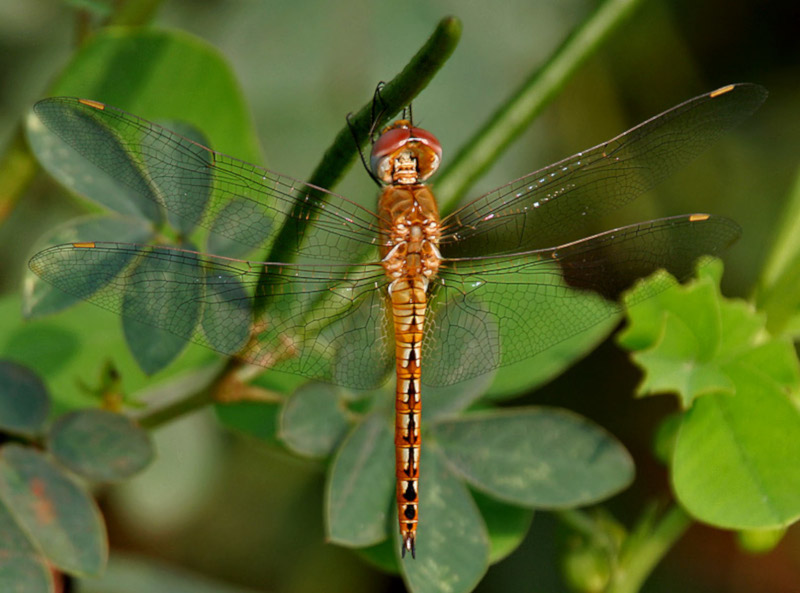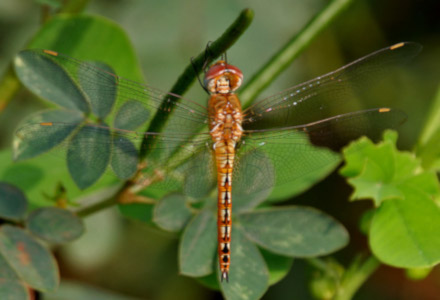
Globe Skimmer Facts
- The attention-grabbing term of Globe Skimmer serves as one of several common names for a remarkable species of dragonfly. The other names by which the invertebrate’s known include the wandering glider and the globe wanderer.
- Among scientists, including entomologists, however, it goes by an altogether different name. That’s the somewhat difficult to pronounce Pantala flavescense. By either name, though, this specific form of dragonfly has some memorable qualities.
- The first official recognition of this creature as an entirely separate and distinct species occurred in the year 1798. That acknowledgement of its status took place at the hands of the highly respected Danish zoologist, Pantheinae Fabricius.
- The Globe Skimmer also has advantages that many similar species do not, including a enormous range. For that reason, along with its current numbers, the IUCN presently lists the arthropod on its Red List of Threatened Species as Least Concern.
- Despite both of these factors, though, many experts still consider it to be at some risk. Give its extreme area of habitation, habitat loss does no pose a danger at present. But, the ongoing effects of climate change nevertheless pose a threat to it.
Related Articles
Socotra Bluet Red Veined Darter Black Darter
Globe Skimmer Physical Description
As an example of its kind, the beautiful Globe Skimmer, despite its other attributes, constitutes only an average-sized species of dragonfly. This wonder of Nature also displays a slight degree of the physiological characteristic of sexual dimorphism.
Among this arthropod, however, that trait manifests itself in other ways than in sheer size. Mature adults of both genders attain a maximum measured body length of 1.77 in (4.5 cm). Wingspans measure up to a known maximum of 3.3 in (9.4 cm).
Overall, both sexes display a yellowish-red on the front of the head, and a golden-yellow thorax, with a single dark line, and a covering of fine hair. Individuals possessing either a brown or olive colored thorax occasionally appear, however, due to random variations.
Its strongly chestnut-red colored eyes actually cover a significant portion of its head, which remains a common trait among dragonflies. Its abdomen also usually displays a similar color as the thorax, while the wings typically develop as clear and broad at the base.
- Kingdom: Animalia
- Phylum: Arthropoda
- Class: Insecta
- Order: Odonata
- Family: Libellulidae
- Genus: Pantala
- Species: P. flavescens
Globe Skimmer Distribution, Habitat, and Ecology
The very name of the Globe Skimmer provides one with a fair image of the incredible range it inhabits. This represents the majority of the continents of the world, in fact, only excluding Antarctica. It doesn’t inhabit the entire area of the continents, though.
This marvel of Nature lives in the areas where the annual average temperature remains around 68 F (20 C). In Europe, only occasional sightings of the species occur, with serious evidence to date mainly from the Aegean Sea and the adjacent mainland.
A potential explanation for the scarcity in Europe of this otherwise common species is the barrier effect of the Sahara Desert, which generates strong winds. These include what’s known as the Sirocco, whose dryness makes dragonfly passage almost impossible.
More evidence of the preference of the Globe Skimmer for moist winds is that the dragonfly migrates to Southeast India’s Tamil Nadu only after the second monsoon which brings the rain to that region. In the rest of India, however, it arrives with the first monsoon.
Observational evidence suggest that it migrates from India or beyond to Africa across the Arabian Sea. As a result of this range, it’s the most widespread of all known dragonflies. It’s also the highest flying, having been seen as high as 20,341 ft (6,200 m).
Although the lifespan of the aptly-named Globe Skimmer isn’t known, its dietary activities are. The larvae consume mainly tiny aquatic invertebrates, such as insect larvae. Adults, however, prey on such creatures as mosquitoes, ants, and termites.
Species Sharing Its Range
Opossum Hooker’s Lips African Penguin
Check out our other articles on 4 Extraordinary Freshwater Fish, Vietnamese Mossy Frog, Blood Falls, Christmas Cheer, Golden-Handed Tamarin, Pea Crab, Plumed Basilisk

